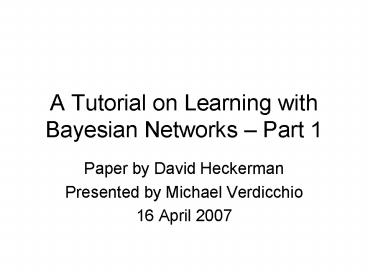A Tutorial on Learning with Bayesian Networks Part 1 - PowerPoint PPT Presentation
1 / 21
Title:
A Tutorial on Learning with Bayesian Networks Part 1
Description:
A Tutorial on Learning with Bayesian Networks Part ... We'll cover this tutorial over 3-4 talks. No prior experience/knowledge assumed ... Why This Tutorial? ... – PowerPoint PPT presentation
Number of Views:285
Avg rating:3.0/5.0
Title: A Tutorial on Learning with Bayesian Networks Part 1
1
A Tutorial on Learning with Bayesian Networks
Part 1
- Paper by David Heckerman
- Presented by Michael Verdicchio
- 16 April 2007
2
Overview
- Well cover this tutorial over 3-4 talks
- No prior experience/knowledge assumed
- Talk 1 Background, probability, Bayesian
approach to probability - Talk 2 Probabilistic inference algorithms,
learning probabilities, incomplete data - Talks 3/4 Learning parameters and structure,
model selection, causal relationships, pertinent
topics
3
Todays Talking Points
- Introduction Why and what
- Review of classical probability theory
- Bayesian approach to classical probability and
statistics
4
Why This Tutorial?
- Computational Systems Biology lab will benefit
from knowledge and application of Bayesian
approaches to biomedical data - We will expand our repertory of data analysis
techniques for our own research - We will be better able to critically evaluate the
works of others
5
What is a Bayesian Network (BN)?
- Graphical model for probabilistic relationships
among a set of variables - Many data analysis techniques exist, so what
advantages do BNs have?
6
Advantages of BNs
- BNs can readily handle incomplete data
- BNs allow learning about causal relationships
- BNs facilitate combination of domain knowledge
with data - Bayesian methods with BNs and other models avoid
the over fitting of data
7
Todays Talking Points
- Introduction Why and what
- Review of classical probability theory
- Bayesian approach to classical probability and
statistics
8
Some Basic Definitions
- The sample space is the collection of all
outcomes for a well-defined experiment - Every subset of a sample space is called an
event, with singleton subsets called elementary
events - A function assigning a real number p(E) to each
event E in a sample space O is called a
probability function - The pair (O,p) is called a probability space
9
Theorem
- Let (O,p) be a probability space. Then
- p(O) 1
- 0 p(E) 1 for every E in O
- For E and F in O s.t.
- Example Choose a queen or a king from a deck of
cards
10
Definitions
- Let E and F be events such that p(F) ? 0. Then
the conditional probability of E given F, denoted
p(EF), is given by - Two events E and F are conditionally independent
if one of the following holds - 1. p(E) ? 0, p(F) ? 0 and p(EF) p(E)
- 2. p(E) 0 or p(F) 0
11
Total Probability
- Suppose we have n events such that each pair-wise
intersection is empty and the union of all events
is the sample space - Such events are mutually exclusive and
exhaustive, and for any other event F, - and if p(Ei) ? 0 for all i,
12
Bayes Theorem
- Given two events E and F s.t. p(E) ? 0 and p(F) ?
0, we have the following - Given n elementary events E1, E2, , En s.t.
p(Ei) ? 0 for all i, we have for 1 i n,
13
Todays Talking Points
- Introduction Why and what
- Review of classical probability theory
- Bayesian approach to classical probability and
statistics
14
Notation
15
Classical------------------Bayesian
- Probability is a physical property
- Requires repeated trials for probability
- Probability is ones degree of belief
- Only cares about the probability of next trial
16
The Thumbtack Problem
- In the classical analysis, we estimate the
physical probability of heads from the N
observations, using this probability for the
N1th toss - In the Bayesian analysis, we also assess some
physical probability of heads, but we encode our
uncertainty using Bayesian probabilities, and use
the rules of probability to compute our
probability of heads on the N1th toss
17
The Thumbtack Problem
- We define T to be a variable whose values ?
correspond to the possible true values of the
physical probability of tossing heads - We express uncertainty about T using the
probability density function p(??), where ?
represents a state of information - In Bayesian terms, the thumbtack problem reduces
to computing p(xN1D,?) from p(??)
18
The Thumbtack Problem
- First, use Bayes rule to get the probability
distribution for T given D and ? - To make predictions, average over possible values
of T to determine the probability for the N1th
toss
19
The Thumbtack Problem
- In the Bayesian approach, D is fixed and we
imagine all values of ? that could have been
generated - Given ?, the estimate of the physical probability
is just ? itself - Nonetheless, we are uncertain about ?, and so our
final estimate is the expectation of ?
20
The Thumbtack Problem
- In contrast, in the classical approach, ? is
fixed and we imagine all data that may be
generated by sampling the ? distribution - Each data set will occur with some probability
and produce an estimate - An estimator is chosen to balance bias and
variance - This estimator is applied to observed data
21
Coming up in future talks
- Bayesian networks (construction)
- Inference in a Bayesian network
- Learning probabilities in a Bayesian network
- Much, much more!































